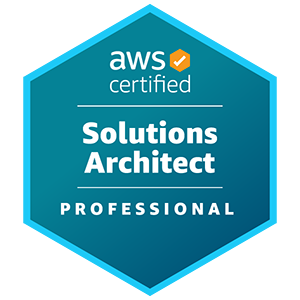Key Features

Training Mode
Classroom and Online

Learning Method
Lecture & Self-Study

Lecture & Self-Study
1 Month

Training Hours
3 Hours per day

Hands on Labs
Yes

Study Material
Yes

Certificate
Yes

Batches
(Mon-Thu) & (Sat-Sun)
AWS Certified Solutions Architect Professional

AWS Certified Solutions Architect – Professional showcases knowledge and skills in providing complex solutions to complex problems, optimizing security, cost, and performance, and automating manual processes. This certification is a means for organizations to identify and develop talent with these critical skills for implementing cloud initiatives.
The AWS Certified Solutions Architect – Professional (SAP-C02) exam is intended for individuals who perform a solutions architect role. The exam validates a candidate’s advanced technical skills and experience in designing optimized AWS solutions that are based on the AWS Well-Architected Framework.
It validates a candidate’s ability to complete the following tasks:
- Design for organizational complexity
- Design for new solutions
- Continuously improve existing solutions
- Accelerate workload migration and modernization
AWS Certified Solutions Architect Professional
Course Duration
- 2 month of Instructor-led classroom training
- 2 month of instructor-led online training
Who should enroll?
AWS Certified Solutions Architect – Professional is intended for individuals with two or more years of hands-on experience designing and deploying cloud architecture on AWS. Before you take this exam, we recommend you have:
- Familiarity with AWS CLI, AWS APIs, AWS CloudFormation templates, the AWS Billing Console, the AWS Management Console, a scripting language, and Windows and Linux environments
- Ability to provide best practice guidance on the architectural design across multiple applications and projects of the enterprise as well as an ability to map business objectives to application/architecture requirements
- Ability to evaluate cloud application requirements and make architectural recommendations for implementation, deployment, and provisioning applications on AWS
- Ability to design a hybrid architecture using key AWS technologies (e.g., VPN, AWS Direct Connect) as well as a continuous integration and deployment process
What you'll learn in this course?
Preparing for and attaining this certification will showcase:
- Knowledge and skills in designing scalable systems
- Knowledge and skills in configuring access to IAM
- Amazon VPC and EC2
- Amazon Machine Images (AMI)
- AWS Lambda
- Amazon S3
- Knowledge and skills in Databases of AMI
- Knowledge and skills in Application services of AWS
- Knowledge and skills in Cloud deployment security practices
Devices during Hands-on Labs
Jobs?
- Senior DevOps Engineer
- AWS Cloud Data DevOps Engineer
- AWS DevOps Trainer
- Cloud Consultant
Prerequisites
Before taking this course, candidates should be familiar with
- Familiarity with general networking concepts
- Familiarity with AWS CLI, AWS APIs, AWS CloudFormation templates, the AWS Billing Console, the AWS Management Console, a scripting language, and Windows and Linux environments
- Ability to provide best practice guidance on the architectural design across multiple applications and projects of the enterprise as well as an ability to map business objectives to application/architecture requirements
- Candidate should have at least 2 year of hands-on experience designing cloud solutions that use AWS services.
Introduction
The AWS Certified Solutions Architect – Professional (SAP-C02) exam is intended for individuals who perform a solutions architect role. The exam validates a candidate’s advanced technical skills and experience in designing optimized AWS solutions that are based on the AWS Well-Architected Framework.
The exam also validates a candidate’s ability to complete the following tasks within the scope of the AWS
Well-Architected Framework:
- Design for organizational complexity
- Design for new solutions
- Continuously improve existing solutions
- Accelerate workload migration and modernization
Target candidate description
The target candidate has 2 or more years of experience in using AWS services to design and implement cloud solutions. This candidate has the ability to evaluate cloud application requirements and make architectural recommendations for deployment of applications on AWS. The target candidate also can provide expert guidance about architectural design that extends across multiple applications and projects within a complex organization.
Training Outline
Response types
There are two types of questions on the exam:
• Multiple choice: Has one correct response and three incorrect responses (distractors)
• Multiple response: Has two or more correct responses out of five or more response options
Select one or more responses that best completes the statement or answers the question. Distractors, or
incorrect answers, are response options that a candidate with incomplete knowledge or skill might choose.
Distractors are generally plausible responses that match the content area.
Unanswered questions are scored as incorrect; there is no penalty for guessing. The exam includes 65
questions that will affect your score.
Unscored content
The exam includes 10 unscored questions that do not affect your score. AWS collects information about
candidate performance on these unscored questions to evaluate these questions for future use as scored
questions. These unscored questions are not identified on the exam.
Exam results
The AWS Certified Solutions Architect – Professional (SAP-C02) exam is a pass or fail exam. The exam is
scored against a minimum standard established by AWS professionals who follow certification industry
best practices and guidelines.
Your results for the exam are reported as a scaled score of 100–1,000. The minimum passing score is 750.
Your score shows how you performed on the exam as a whole and whether or not you passed. Scaled
scoring models help equate scores across multiple exam forms that might have slightly different difficulty
levels.
Your score report could contain a table of classifications of your performance at each section level. This
information is intended to provide general feedback about your exam performance. The exam uses a compensatory scoring model, which means that you do not need to achieve a passing score in each
section. You need to pass only the overall exam.
Each section of the exam has a specific weighting, so some sections have more questions than other
sections have. The table contains general information that highlights your strengths and weaknesses. Use
caution when interpreting section-level feedback. Candidates who pass the exam will not receive this
additional information.
This exam guide includes weightings, test domains, and task statements for the exam. It is not a comprehensive listing of the content on the exam. However, additional context for each of the task statements is available to help guide your preparation for the exam. The following table lists the main content domains and their weightings. The table precedes the complete exam content outline, which includes the additional context. The percentage in each domain represents only scored content.
| Domain | % of Exam |
| Domain 1: Design Solutions for Organizational Complexity | 26% |
| Domain 2: Design for New Solutions | 29% |
| Domain 3: Continuous Improvement for Existing Solutions | 25% |
| Domain 4: Accelerate Workload Migration and Modernization | 20% |
| Total | 100% |
Task Statement 1: Architect network connectivity strategies.
Knowledge of:
- AWS global infrastructure
- AWS networking concepts (for example, Amazon VPC, AWS Direct Connect, AWS VPN, transitive routing, AWS container services)
- Hybrid DNS concepts (for example, Amazon Route 53 Resolver, on-premises DNS integration)
- Network segmentation (for example, subnetting, IP addressing, connectivity among VPCs)
- Network traffic monitoring
Skills in:
- Evaluating connectivity options for multiple VPCs
- Evaluating connectivity options for on-premises, co-location, and cloud integration
- Selecting AWS Regions and Availability Zones based on network and latency requirements
- Troubleshooting traffic flows by using AWS tools
- Utilizing service endpoints for service integrations
Task Statement 2: Prescribe security controls.
Knowledge of:
- AWS Identity and Access Management (IAM) and AWS Single Sign-On
- Route tables, security groups, and network ACLs
- Encryption keys and certificate management (for example, AWS Key Management Service
[AWS KMS], AWS Certificate Manager [ACM]) - AWS security, identity, and compliance tools (for example, AWS CloudTrail, AWS Identity and
Access Management Access Analyzer, AWS Security Hub, Amazon Inspector)
Skills in:
- Evaluating cross-account access management
- Integrating with third-party identity providers
- Deploying encryption strategies for data at rest and data in transit
- Developing a strategy for centralized security event notifications and auditing
Task Statement 3: Design reliable and resilient architectures.
Knowledge of:
- Recovery time objectives (RTOs) and recovery point objectives (RPOs)
- Disaster recovery strategies (for example, using AWS Elastic Disaster Recovery [CloudEndure Disaster Recovery], pilot light, warm standby, and multi-site)
- Data backup and restoration
Skills in:
- Designing disaster recovery solutions based on RTO and RPO requirements
- Implementing architectures to automatically recover from failure
- Developing the optimal architecture by considering scale-up and scale-out options
- Designing an effective backup and restoration strategy
Task Statement 4: Design a multi-account AWS environment.
Knowledge of:
- AWS Organizations and AWS Control Tower
- Multi-account event notifications
- AWS resource sharing across environments
Skills in:
- Evaluating the most appropriate account structure for organizational requirements
- Recommending a strategy for central logging and event notifications
- Developing a multi-account governance model
Task Statement 5: Determine cost optimization and visibility strategies.
Knowledge of:
- AWS cost and usage monitoring tools (for example, AWS Trusted Advisor, AWS Pricing
Calculator, AWS Cost Explorer, AWS Budgets) - AWS purchasing options (for example, Reserved Instances, Savings Plans, Spot Instances)
- AWS right-sizing visibility tools (for example, AWS Compute Optimizer, Amazon S3 Storage
Lens)
Skills in:
- Monitoring cost and usage with AWS tools
- Developing an effective tagging strategy that maps costs to business units
- Understanding how purchasing options affect cost and performance
Task Statement 1: Design a deployment strategy to meet business requirements.
Knowledge of:
- Infrastructure as code (IaC) (for example, AWS CloudFormation)
- Continuous integration/continuous delivery (CI/CD)
- Change management processes
- Configuration management tools (for example, AWS Systems Manager)
Skills in:
- Determining an application or upgrade path for new services and features
- Selecting services to develop deployment strategies and implement appropriate rollback mechanisms
- Adopting managed services as needed to reduce infrastructure provisioning and patching overhead
- Making advanced technologies accessible by delegating complex development and deployment tasks to AWS
Task Statement 2: Design a solution to ensure business continuity.
Knowledge of:
- AWS global infrastructure
- AWS networking concepts (for example, Route 53, routing methods)
- RTOs and RPOs
- Disaster recovery scenarios (for example, backup and restore, pilot light, warm standby, multi-site)
- Disaster recovery solutions on AWS
Skills in:
- Configuring disaster recovery solutions
- Configuring data and database replication
- Performing disaster recovery testing
- Architecting a backup solution that is automated, is cost-effective, and supports business continuity across multiple Availability Zones and/or AWS Regions
- Designing an architecture that provides application and infrastructure availability in the event of a disruption
- Leveraging processes and components for centralized monitoring to proactively recover from system failures
Task Statement 3: Determine security controls based on requirements.
Knowledge of:
- IAM
- Route tables, security groups, and network ACLs
- Encryption options for data at rest and data in transit
- AWS service endpoints
- Credential management services
- AWS managed security services (for example, AWS Shield, AWS WAF, Amazon GuardDuty, AWS Security Hub)
Skills in:
- Specifying IAM users and IAM roles that adhere to the principle of least privilege access
- Specifying inbound and outbound network flows by using security group rules and network ACL rules
- Developing attack mitigation strategies for large-scale web applications
- Developing encryption strategies for data at rest and data in transit
- Specifying service endpoints for service integrations
- Developing strategies for patch management to remain compliant with organizational standards
Task Statement 4: Design a strategy to meet reliability requirements.
Knowledge of:
- AWS global infrastructure
- AWS storage services and replication strategies (for example Amazon S3, Amazon RDS, Amazon ElastiCache)
- Multi-AZ and multi-Region architectures
- Auto scaling policies and events
- Application integration (for example, Amazon Simple Notification Service [Amazon SNS], Amazon Simple Queue Service [Amazon SQS], AWS Step Functions)
- Service quotas and limits
Skills in:
- Designing highly available application environments based on business requirements
- Leveraging advanced techniques to design for failure and ensure seamless system recoverability
- Implementing loosely coupled dependencies
- Operating and maintaining high-availability architectures (for example, application failovers,
database failovers) - Leveraging AWS managed services for high availability
- Implementing DNS routing policies (for example, Route 53 latency-based routing, geolocation
routing, simple routing)
Task Statement 5: Design a solution to meet performance objectives.
Knowledge of:
- Performance monitoring technologies
- Storage options on AWS
- Instance families and use cases
- Purpose-built databases
Skills in:
- Designing large-scale application architectures for a variety of access patterns
- Designing an elastic architecture based on business objectives
- Applying design patterns to meet performance objectives with caching, buffering, and replicas
- Developing a process methodology for selecting purpose-built services for required tasks
- Designing a right-sizing strategy
Task Statement 6: Determine a cost optimization strategy to meet solution goals and objectives.
Knowledge of:
- AWS cost and usage monitoring tools (for example, Cost Explorer, Trusted Advisor, AWS
Pricing Calculator) - Pricing models (for example, Reserved Instances, Savings Plans)
- Storage tiering
- Data transfer costs
- AWS managed service offerings
Skills in:
- Identifying opportunities to select and right size infrastructure for cost-effective resources
- Identifying appropriate pricing models
- Performing data transfer modeling and selecting services to reduce data transfer costs
- Developing a strategy and implementing controls for expenditure and usage awareness
Task Statement 1: Determine a strategy to improve overall operational excellence.
Knowledge of:
- Alerting and automatic remediation strategies
- Disaster recovery planning
- Monitoring and logging solutions (for example, Amazon CloudWatch)
- CI/CD pipelines and deployment strategies (for example, blue/green, all-at-once, rolling)
- Configuration management tools (for example, Systems Manager)
Skills in:
- Determining the most appropriate logging and monitoring strategy
- Evaluating current deployment processes for improvement opportunities
- Prioritizing opportunities for automation within a solution stack
- Recommending the appropriate AWS solution to enable configuration management automation
- Engineering failure scenario activities to support and exercise an understanding of recovery actions
Task Statement 2: Determine a strategy to improve security.
Knowledge of:
- Data retention, data sensitivity, and data regulatory requirements
- Automated monitoring and remediation strategies (for example, AWS Config rules)
- Secrets management (for example, Systems Manager, AWS Secrets Manager)
- Principle of least privilege access
- Security-specific AWS solutions
- Patching practices
- Backup practices and methods
Skills in:
- Evaluating a strategy for the secure management of secrets and credentials
- Auditing an environment for least privilege access
- Reviewing implemented solutions to ensure security at every layer
- Reviewing comprehensive traceability of users and services
- Prioritizing automated responses to the detection of vulnerabilities
- Designing and implementing a patch and update process
- Designing and implementing a backup process
- Employing remediation techniques
Task Statement 3: Determine a strategy to improve performance.
Knowledge of:
- High-performing systems architectures (for example, auto scaling, instance fleets, and placement groups)
- Global service offerings (for example, AWS Global Accelerator, Amazon CloudFront, and edge
computing services) - Monitoring tool sets and services (for example, CloudWatch)
- Service level agreements (SLAs) and key performance indicators (KPIs)
Skills in:
- Translating business requirements to measurable metrics
- Testing potential remediation solutions and making recommendations
- Proposing opportunities for the adoption of new technologies and managed services
- Assessing solutions and applying right sizing based on requirements
- Identifying and examining performance bottlenecks
Task Statement 4: Determine a strategy to improve reliability.
Knowledge of:
- AWS global infrastructure
- Data replication methods
- Scaling methodologies (for example, load balancing, auto scaling)
- High availability and resiliency
- Disaster recovery methods and tools
- Service quotas and limits
Skills in:
- Understanding application growth and usage trends
- Evaluating existing architecture to determine areas that are not sufficiently reliable
- Remediating single points of failure
- Enabling data replication, self-healing, and elastic features and services
Task Statement 5: Identify opportunities for cost optimizations.
Knowledge of:
- Cost-conscious architecture choices (for example, utilizing Spot Instances, scaling policies, and right-sizing resources)
- Price model adoptions (for example, Reserved Instances, Savings Plans)
- Networking and data transfer costs
- Cost management, alerting, and reporting
Skills in:
- Analyzing usage reports to identify underutilized and overutilized resources
- Utilizing AWS solutions to identify unused resources
- Designing billing alarms based on expected usage patterns
- Investigating AWS Cost and Usage Reports at a granular level
- Utilizing tagging for cost allocation and reporting
Task Statement 1: Select existing workloads and processes for potential migration.
Knowledge of:
- Migration assessment and tracking tools (for example, AWS Migration Hub)
- Portfolio assessment
- Asset planning
- Prioritization and migration of workloads (for example, wave planning)
Skills in:
- Completing an application migration assessment
- Evaluating applications according to the seven common migration strategies (7Rs)
- Evaluating total cost of ownership (TCO)
Task Statement 2: Determine the optimal migration approach for existing workloads.
Knowledge of:
- Data migration options and tools (for example, AWS DataSync, AWS Transfer Family, AWS Snow Family, S3 Transfer Acceleration)
- Application migration tools (for example, AWS Application Discovery Service, AWS Application
Migration Service [CloudEndure Migration], AWS Server Migration Service [AWS SMS]) - AWS networking services and DNS (for example, Direct Connect, AWS Site-to-Site VPN, Route 53)
- Identity services (for example, AWS SSO, AWS Directory Service)
- Database migration tools (for example, AWS Database Migration Service [AWS DMS], AWS Schema Conversion Tool [AWS SCT])
- Governance tools (for example, AWS Control Tower, Organizations)
Skills in:
- Selecting the appropriate database transfer mechanism
- Selecting the appropriate application transfer mechanism
- Selecting the appropriate data transfer service and migration strategy
- Applying the appropriate security methods to migration tools
- Selecting the appropriate governance model
Task Statement 3: Determine a new architecture for existing workloads.
Knowledge of:
- Compute services (for example, Amazon EC2, AWS Elastic Beanstalk)
- Containers (for example, Amazon Elastic Container Service [Amazon ECS], Amazon Elastic Kubernetes Service [Amazon EKS], AWS Fargate, Amazon Elastic Container Registry [Amazon
ECR]) - AWS storage services (for example, Amazon Elastic Block Store [Amazon EBS], Amazon Elastic File System [Amazon EFS], Amazon FSx, Amazon S3, Volume Gateway)
- Databases (for example, Amazon DynamoDB, Amazon OpenSearch Service [Amazon Elasticsearch Service], Amazon RDS, self-managed databases on Amazon EC2)
Skills in:
- Selecting the appropriate compute platform
- Selecting the appropriate container hosting platform
- Selecting the appropriate storage service
- Selecting the appropriate database platform
Task Statement 4: Determine opportunities for modernization and enhancements.
Knowledge of:
- Serverless compute offerings (for example, AWS Lambda)
- Containers (for example, Amazon ECS, Amazon EKS, AWS Fargate)
- AWS storage services (for example, Amazon S3, Amazon EFS)
- Purpose-built databases (for example, DynamoDB, Amazon Aurora Serverless, ElastiCache)
- Integration service (for example, Amazon SQS, Amazon SNS, Amazon EventBridge [Amazon CloudWatch Events], Step Functions)
Skills in:
- Identifying opportunities to decouple application components
- Identifying opportunities for serverless solutions
- Selecting the appropriate service for containers
- Identifying opportunities for purpose-built databases
- Selecting the appropriate application integration service
Which key tools, technologies, and concepts might be covered on the exam?
The following is a non-exhaustive list of the tools and technologies that could appear on the exam. This list is subject to change and is provided to help you understand the general scope of services, features, or technologies on the exam. The general tools and technologies in this list appear in no particular order. AWS services are grouped according to their primary functions. While some of these technologies will likely be covered more than others on the exam, the order and placement of them in this list is no indication of relative weight or importance:
- Compute
- Cost management
- Database
- Disaster recovery
- High availability
- Management and governance
- Microservices and component decoupling
- Migration and data transfer
- Networking, connectivity, and content delivery
- Security
- Serverless design principles
- Storage
In-scope AWS services and features
Analytics:
- Amazon Athena
- AWS Data Exchange
- AWS Data Pipeline
- Amazon EMR
- AWS Glue
- Amazon Kinesis Data Analytics
- Amazon Kinesis Data Firehose
- Amazon Kinesis Data Streams
- AWS Lake Formation
- Amazon Managed Streaming for Apache Kafka (Amazon MSK)
- Amazon OpenSearch Service
- Amazon QuickSight
Application Integration:
- Amazon AppFlow
- AWS AppSync
- Amazon EventBridge (Amazon CloudWatch Events)
- Amazon MQ
- Amazon Simple Notification Service (Amazon SNS)
- Amazon Simple Queue Service (Amazon SQS)
- AWS Step Functions
Business Applications:
- Alexa for Business
- Amazon Simple Email Service (Amazon SES)
Blockchain:
- Amazon Managed Blockchain Cloud Financial
Management:
- AWS Budgets
- AWS Cost and Usage Report
- AWS Cost Explorer
- Savings Plans
Compute:
- AWS App Runner
- AWS Auto Scaling
- AWS Batch
- Amazon EC2
- Amazon EC2 Auto Scaling
- AWS Elastic Beanstalk
- Amazon Elastic Kubernetes Service (Amazon EKS)
- Elastic Load Balancing
- AWS Fargate
- AWS Lambda
- Amazon Lightsail
- AWS Outposts
- AWS Wavelength
Containers:
- Amazon Elastic Container Registry (Amazon ECR)
- Amazon Elastic Container Service (Amazon ECS)
- Amazon ECS Anywhere
- Amazon Elastic Kubernetes Service (Amazon EKS)
- Amazon EKS Anywhere
- Amazon EKS Distro
Database:
- Amazon Aurora
- Amazon Aurora Serverless
- Amazon DocumentDB (with MongoDB compatibility)
- Amazon DynamoDB
- Amazon ElastiCache
- Amazon Keyspaces (for Apache Cassandra)
- Amazon Neptune
- Amazon RDS
- Amazon Redshift
- Amazon Timestream
Developer Tools:
- AWS Cloud9
- AWS CodeArtifact
- AWS CodeBuild
- AWS CodeCommit
- AWS CodeDeploy
- Amazon CodeGuru
- AWS CodePipeline
- AWS CodeStar
- AWS X-Ray
End User Computing:
- Amazon AppStream 2.0
- Amazon WorkSpaces
Frontend Web and Mobile:
- AWS Amplify
- Amazon API Gateway
- AWS Device Farm
- Amazon Pinpoint
Internet of Things:
- AWS IoT Analytics
- AWS IoT Core
- AWS IoT Device Defender
- AWS IoT Device Management
- AWS IoT Events
- AWS IoT Greengrass
- AWS IoT SiteWise
- AWS IoT Things Graph
- AWS IoT 1-Click
Machine Learning:
- Amazon Comprehend
- Amazon Forecast
- Amazon Fraud Detector
- Amazon Kendra
- Amazon Lex
- Amazon Personalize
- Amazon Polly
- Amazon Rekognition
- Amazon SageMaker
- Amazon Textract
- Amazon Transcribe
- Amazon Translate
Management and Governance:
- AWS CloudFormation
- AWS CloudTrail
- Amazon CloudWatch
- Amazon CloudWatch Logs
- AWS Command Line Interface (AWS CLI)
- AWS Compute Optimizer
- AWS Config
- AWS Control Tower
- AWS License Manager
- Amazon Managed Grafana
- Amazon Managed Service for Prometheus
- AWS Management Console
- AWS Organizations
- AWS Personal Health Dashboard
- AWS Proton
- AWS Service Catalog
- Service Quotas
- AWS Systems Manager
- AWS Trusted Advisor
- AWS Well-Architected Tool
Media Services:
- Amazon Elastic Transcoder
- Amazon Kinesis Video Streams
Migration and Transfer:
- AWS Application Discovery Service
- AWS Application Migration Service (CloudEndure Migration)
- AWS Database Migration Service (AWS DMS)
- AWS DataSync
- AWS Migration Hub
- AWS Schema Conversion Tool (AWS SCT)
- AWS Snow Family
- AWS Transfer Family
Networking and Content Delivery:
- Amazon CloudFront
- AWS Direct Connect
- Elastic Load Balancing (ELB)
- AWS Global Accelerator
- AWS PrivateLink
- Amazon Route 53
- AWS Transit Gateway
- Amazon VPC
- AWS VPN
Security, Identity, and Compliance:
- AWS Artifact
- AWS Audit Manager
- AWS Certificate Manager (ACM)
- AWS CloudHSM
- Amazon Cognito
- Amazon Detective
- AWS Directory Service
- AWS Firewall Manager
- Amazon GuardDuty
- AWS Identity and Access Management (IAM)
- Amazon Inspector
- AWS Key Management Service (AWS KMS)
- Amazon Macie
- AWS Network Firewall
- AWS Resource Access Manager (AWS RAM)
- AWS Secrets Manager
- AWS Security Hub
- AWS Security Token Service (AWS STS)
- AWS Shield
- AWS Single Sign-On
- AWS WAF
Storage:
- AWS Backup
- Amazon Elastic Block Store (Amazon EBS)
- AWS Elastic Disaster Recovery (CloudEndure Disaster Recovery)
- Amazon Elastic File System (Amazon EFS)
- Amazon FSx (for all types)
- Amazon S3
- Amazon S3 Glacier
- AWS Storage Gateway
Out-of-scope services, features, and concepts
The following is a non-exhaustive list of items that are considered out of scope for the exam:
- Amazon GameLift
- Frontend development for mobile apps
- 12-factor app methodology
- In-depth knowledge of operating systems
What to expect in the lab exam?
The 8 hours practical exam will assess candidate’s skills through the entire network lifecycle of designing, deploying, operating and optimizing complex network scenarios. The exam consists out of 2 modules that are fixed in time and will be delivered in a fixed sequence:
Do you provide Placement Assistance, post completion of the training?
We are 100% committed to offer placement assistance to our students. Industry approved Resume Templates are provided to candidates as guidance to assist them in writing their resumes. We also provide students with FAQ interview questionnaire to help them prepare for their job interviews.
What is expected salary after AWS-Certified-Solutions-Architect-Professional Training Course?
On an average a AWS DevOps Engineer – Professional with 3-5 years of experience gets salary in the range of INR 80,000 to 1,00,000 per month in India
After AWS-Certified-Solutions-Architect-Professional training course, what is the Next Step?
Learning never stops. We always recommend AWS-Certified-DevOps-Engineer-Professional (Course link) training. There is huge demand for AWS-Certified-DevOps-Engineer-Professional in market. These training and certification will establish your authority as an industry expert and provide you better career opportunities in the market.
Exam & Training
| Exam Name | Exam Code | Duration | Cost | Registration |
| AWS-Certified Solutions Architect Professional | SAP-C01 | 3 Hours | 300 USD | Pearson VUE |
AWS Certified Solutions Architect Professional

CCIE EI #66320

CCIE EI #26059

CCIE EI #66999

CCIE EI #51924

CCIE EI #50138

CCIE #50724

CCIE #49847
AWS Certified Solutions Architect Professional Success Stories
Completed my AWS Training course - AWS Certified Solutions Architect Associate with Mumbai Networks, and it was an incredibly valuable experience. The course was comprehensive, covering all the necessary topics to get up and running with AWS. The instructors were knowledgeable and extremely helpful, and they made sure to provide plenty of practical examples and hands-on exercises. All the necessary materials were provided and the course was easy to follow. Overall, I highly recommend this course with Mumbai Networks to anyone looking to get started with AWS.
I recently took a AWS course with Mumbai Networks Training (AWS Certified DevOps Engineer Professional) and I was very pleased with the quality of the material and the level of expertise provided. The course was comprehensive and covered a wide range of topics that were essential for understanding the fundamentals of networking. The instructor was highly knowledgeable and provided practical insight that was applicable to my daily job. I highly recommend Network Training for anyone looking for a comprehensive and well-structured training program.
I recently completed the AWS Certified SysOps Administrator Associate Training course with Mumbai Networks and found it to be an incredibly helpful and informative experience. The course was well organized and easy to understand, and I felt that the instructors did an excellent job of explaining the concepts and principles of AWS. The course provided me with a solid foundation of knowledge that I can use to further my development in the cloud. I was able to get a lot of hands-on experience and was pleased with the quality of the content from Mumbai Networks team. I would highly recommend Mumbai Networks to anyone looking to start their cloud journey. AWS Training is a great way to get the most out of your cloud experience.
Recently took the AWS Training course with Mumbai Networks and it was an absolute pleasure. The instructor was very knowledgeable and had a great deal of experience in the AWS platform. The course material was easy to understand and follow, and the course was well-structured and very informative. The material was also up to date with the latest AWS tools and technologies, which made it easier to apply my new knowledge. I highly recommend this course to anyone looking to learn more about the AWS platform and its capabilities.
Had the opportunity to take an AWS Training course with Mumbai Networks, and I must say that I was incredibly impressed with the level of knowledge and professionalism of the instructors. The course material was comprehensive and up-to-date with the latest AWS technologies and best practices, and the instructors were always available to answer any questions I had. I learned a great deal during my time in the course, and I would highly recommend Mumbai Networks AWS Training to anyone looking to learn more about the world of cloud computing.
Attended an AWS Cloud Practitioner course from Mumbai Networks and I was very impressed with the quality and depth of the content. The instructor was very knowledgeable and the course materials were comprehensive and up-to-date. I learned a lot about the various AWS products and services, and the course gave me a good starting point to develop my understanding further. Overall, I highly recommend AWS Training for anyone looking to learn more about the AWS platform.
I recently took the AWS Training course with Mumbai Networks and I highly recommend it. The course was comprehensive and the instructor was knowledgeable and very helpful. The lectures were easy to understand and the interactive labs enabled me to practice my skills. The course provided me with the necessary tools and knowledge to become AWS certified. There was also a great support team available for any questions or doubts. Overall, I had a great experience and would definitely recommend Mumbai Networks AWS Training to anyone looking to learn more about AWS.
FAQ on AWS Certified Solutions Architect Professional
Standard cost for AWS Solution Architect Professional Certification Course cost is Rs 55,000 per participant. We keep on giving exciting discounts to our participants. Check the current discounted price. Please get in touch with us at [email protected] to know more about group discounts.
Yes, we do have a group and corporate discount packages for classroom training programs. Please get in touch with us at [email protected] to know more about group discounts.
Of Course! How else will you go through the topics you heard about then? We provide hard and soft copies of the entire study material to you right after the training session!









